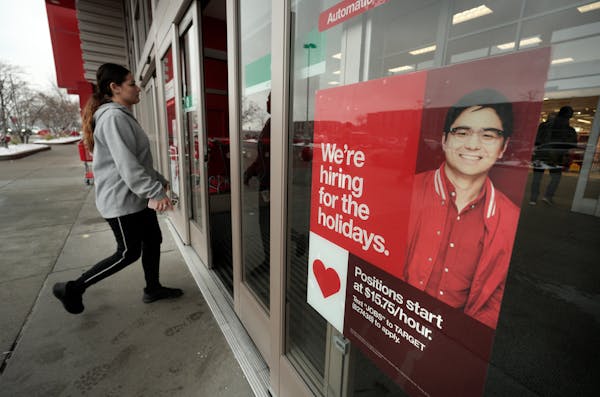Wage inequality has decreased in Minnesota over the past five years as lower-wage workers have seen bigger pay bumps.
But at the same time, overall wages have not kept up with inflation, undercutting some of that progress.
Those are some of the recent findings by economic analysts at the Minnesota Department of Employment and Economic Development (DEED), who have published a series of articles on the topic.
In one report, Mustapha Hammida found that wages in Minnesota were growing at a healthy clip in the few years before COVID-19 hit, picked up more speed in 2020 and accelerated again in 2022. While wages have risen across the spectrum, they've grown the fastest for workers in the bottom half.
For example, while about 30% of workers were making $15 an hour or less in 2017, that percentage declined to about 11% by the second quarter of 2022. Meanwhile, the share of workers in higher-wage tiers increased over that same time.
"The shift that occurred in wage distribution has been moving to the right," Hammida said. "And that resulted in something that is very nice to have, which is a reduction in wage inequality."
It's a trend that other states, and the country as a whole, also have been experiencing, he said.
For his analysis, Hammida crunched data that employers report to the state as part of the unemployment insurance program. He found the biggest change has been in the difference between the highest and lowest earners.
In 2017, the hourly wages of the top 10% of earners in Minnesota were 4.8 times that of workers in the bottom tenth. By 2022, that ratio had improved to 4.2.
Still, a wide gap remains. The top 10% of earners accounted for 32% of total earnings in 2022, while the bottom half of workers made up 22%.
Hammida offered some likely explanations for the strong wage growth, particularly at the lower levels. One is the state's tight labor market that pre-dated the pandemic and forced employers to work harder to attract workers.
"When COVID hit, it just actually exacerbated the tightness that's happening in the labor market," he said, pointing to additional factors such as a wave of retirements and challenges with child care.
Minnesota's unemployment rate, already relatively low in the years leading up to the pandemic, plummeted in the spring and summer of 2022 and hit an all-time low of 1.8% last June. It was 2.5% in December, still a historically low level.
Another explanation, Hammida said, was higher minimum wages, including those enacted by Minneapolis and St. Paul, and such employers as Target and Amazon in response to the more competitive landscape for workers. There's a spillover effect from those wage bumps, he said.
His report aligns with other data that has shown that the gap between median white and Black household incomes in Minnesota has contracted in recent years. While the wage data is not broken out by race, DEED economists said Black workers tend to be younger and concentrated in the lower-wage jobs that have seen the most wage growth.
Minnesota's wage levels are relatively high to begin with, often ranking from eighth to 10th highest in the country over the past decade, according to another DEED report by analysts Oriane Casale and Luke Greiner.
In December, Minnesota's average hourly private sector wage was $35.57, compared with $32.73 for the nation.
In recent months, the state has seen high wage growth. In November, for example, wages in Minnesota rose 5.7% on a year-over-year basis. Yet Minnesota was still in the middle of the pack, ranking 24th in terms of highest wage growth for that month, according to the researchers.
"We've had a tight labor market for probably longer than most other states, and that may have driven some wage increases earlier on," Casale said.
Even with that fast wage growth in November, it still did not keep up with inflation, which rose 7.1% during the same one-year period.
In December, wage growth in Minnesota slowed to 3.7%. U.S. inflation also moderated that month, but not by as much, to 6.5%, meaning wages fell further behind the cost of living in the last month of the year.
Wages were generally keeping up with, and often surpassing, inflation for many years up until the pandemic. That reversed in the past two years as inflation climbed to the highest levels in four decades.
Casale said Minnesota's construction and manufacturing industries boosted pay faster than the rate of inflation over the past three years, though not by much.
Most industries did not keep pace with inflation during that period; the largest decline in real wages, adjusted for inflation, came in financial services at 13%, according to the report.
Over the past two years, wage increases in a handful of sectors have managed to beat inflation, Casale said. Those included leisure and hospitality, nursing and residential care, and professional and business services.
"Minnesota employers really did what they needed to do to staff back up after the pandemic," she said. "And particularly for the leisure and hospitality industry, there was really a push to raise wages in order to draw back workers."
Now, she said, the question is: "Is wage growth going to continue at a strong pace once inflation gets tamed?"

Bushel Boy, Minnesota's local tomato grower, sold
After 60 years, federal cuts shutting down Job Corps center in St. Paul

In a first, Minnesota doctors walk their own picket line, then hustle to see patients
It's harder to find a job this year, especially a corporate position

